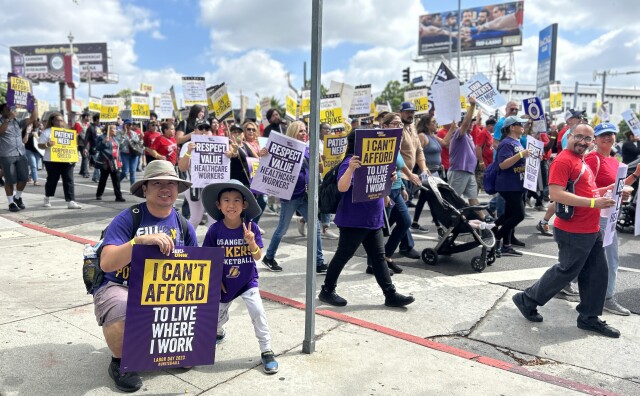Are All These Gloomy Days Leaving You Feeling Down? Here's What You Can Do

In years gone by, this time of year would mean reveling in the additional sunlight provided by daylight savings as we planted our strawberries and lilacs. But storms have been pummeling Los Angeles since January, with the most recent round of atmospheric rivers resulting in on-again, off-again precipitation and downpours.
And that has made typically sunshine-filled Southern California pretty deficient of natural light.
I suppose the moment is upon us, then, to accept that this rain isn’t a fluke or a one-off; it’s here to stay, at least for this season.
With that said, all this gray and cold might have you feeling down. For some people, those weather-related blues could lead to a more severe condition known as seasonal affective disorder, or SAD, which causes clinical depression tied directly to lack of sunlight.
According to experts, clinically diagnosable SAD is less likely to occur in climates like ours, even with the recent gloom, because it’s more often triggered by months of unrelenting gloomy days.
-
Conference aims to boost graduation rates
-
Listen: Campus Gaza protests, snitch scandal, more
-
Gaza solidarity camps in L.A., Riverside, Irvine
But that doesn’t mean it can’t happen and whether it’s clinically diagnosable or not, a lack of sunlight can cause SAD-like symptoms for some people.
What does SAD feel like?
“What's similar in the two situations is the connection between the characteristics of the weather or the climate, and the psychological reaction to it,” said Lawrence A. Palinkas, a professor of social policy and health at USC who researches SAD.
Symptoms of SAD include low energy, sluggishness, problems with sleeping and carbohydrate cravings.
“Many of the symptoms that we experience are almost similar to hibernation,” said Palinkas.
How to feel better
Coping with the disorder, or symptoms that share characteristics with the disorder, often involves preventive measures. Those can include making sure exercise routines are in place prior to the winter months, and preparing your living space with items you know you’ll want or need.
“Preventative measures can come in the form of ensuring that you have physical needs to keep you comfortable, like a jacket, heated blankets or working heater,” said Atalie Abramovici, an associate marriage and family therapist at Root to Rise Therapy in West L.A. “Others come in the form of habits that you've solidified.”
It’s important to get those in place in advance, Abramovici added, because once the gloomy weather hits, it can be harder to start a new routine or take care of yourself properly.
“That way, when that mental barrier of braving the cold comes on, you have a plan,” said Abramovici.
If these measures don’t work or if symptoms persist to the point that they are interrupting your daily routine, it may be time to seek outside help.
More mental health resources
-
- Steinberg Institute website, links to mental health resources and care throughout California
-
- Institute on Aging's 24/7 Friendship Line (especially for people who have disabilities or are over 60), 1-800-971-0016 or call 415-750-4138 to volunteer.
-
- Los Angeles County Department of Mental Health, 24/7 Access Line 1-800-854-7771.
-
- The Crisis Text Line, Text "HOME" (741-741) to reach a trained crisis counselor.
-
- California Psychological Association Find a Psychologist Locator
-
- Psychology Today guide to therapist
-
If You Need Immediate Help
-
- If you or someone you know is in crisis and need immediate help, call the Suicide Prevention Lifeline at 988 or go here for online chat.
-
More Guidance
-
- Find 5 Action Steps for helping someone who may be suicidal, from the National Suicide Prevention Lifeline.
-
- Six questions to ask to help assess the severity of someone's suicide risk, from the Columbia Lighthouse Project.
-
- To prevent a future crisis, here's how to help someone make a safety plan.
-
A medical industry challenge to a $25 minimum wage ordinance in one Southern California city suggests health workers statewide could face layoffs and reductions in hours and benefits under a state law set to begin phasing in in June. Some experts are skeptical, however, that it will have such effects.
-
Charlotte Maya's memoir, "Sushi Tuesdays: A Memoir of Love, Loss, and Family Resilience" is an intimate looks at how she continues to navigate her husband's suicide.
-
Fentanyl and other drugs fuel record deaths among people experiencing homelessness in L.A. County. From 2019 to 2021, deaths jumped 70% to more than 2,200 in a single year.
-
Prosecutors say Stephan Gevorkian's patients include people with cancer. He faces five felony counts of practicing medicine without a certification.
-
April Valentine died at Centinela Hospital. Her daughter was born by emergency C-section. She'd gone into the pregnancy with a plan, knowing Black mothers like herself were at higher risk.
-
Before navigating domestic life in the United States, AAPI immigrants often navigated difficult lives in their motherlands, dealing with everything from poverty to war.






